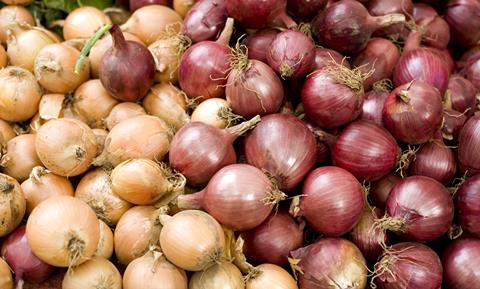
Mark Anthony in Shakespeare’s Cleopatra may have referred to “the tears that live in the onion”. But why do onions actually make us cry? And why do only some onions make us blub in this way when others, including related allium plants such as garlic, barely ever draw a tear when chopped?
When any vegetable is damaged, its cells are ripped open. The plant often then tries to defend itself by releasing bitter-tasting chemicals called polyphenols that can be off-putting to hungry animals trying to eat it. But an onion’s defence mechanism goes further, producing an even more irritating chemical, propanthial s-oxide, meant to stop the plant being consumed by pests.
This volatile chemical is what’s known as a lachrymatory factor. Its volatility means that, once it’s released, it quickly evaporates and finds its way into our eyes. There it dissolves in the water covering the surface of our eyes to form sulphenic acid. This irritates the lacrimal gland also known as the tear gland, hence the rather grand name of lachrymatory factor. Because the amount of acid produced is so small, its effect is only irritating and not harmful.
The release of propanthial s-oxide was originally thought to be down to one enzyme in the onion known as allicinase, a biological catalyst that speeds up the production of the eye-irritating compound. But some research has suggested two enzymes could be needed to produces these eye-watering effects.
This more complex explanation starts with the sulphur the onion absorbs from the ground and holds in a compound called Prencso 1 (1-propenyl-L-cysteine sulphoxide). When the onion is damaged it releases the allicinase, which reacts with the Prencso to produce ammonia and another chemical called 1-propenylsulphenic acid. The second enzyme, known as a lachrymatory-factor synthase, then turns this into the troublesome propanthial s-oxide.
So why do some onions have more of an eye-stinging effect than others? There is lots of debate about this. One plausible explanation is that it’s related to the amount of sulphur the onion has absorbed from the ground, which can depend on the soil and the growing conditions. Higher levels of sulphur in the soil help boost both the yield and pungency of onions.
Certainly sweeter onions tend to have less of the sulphur-containing compounds that eventually produce the propanthial s-oxide. But it’s also possible that no two onions from the same bag will have the same effect, so cutting into the vegetable may be the only way to know if it will make you cry.
However, we have a better idea why onion’s cousin garlic doesn’t have the same effect. It contains a slightly different compound called alliin or Prencso 2, which doesn’t break down further into eye-stinging chemicals. Instead it produces allicin, which has been linked to many of garlic’s health benefits.
Stop the tears
One solution to the crying problem may be to re-engineer the humble onion by selective breeding or genetic modification to suppress the lachrymatory-factor synthase enzyme. This might also have the added benefit of improving how onions taste as less propanthial S-oxide would mean more thiosulphinate, the compound associated with the flavour of fresh onions.
There are also a number of lower-tech solutions that have been suggested to solve the onion-chopping problem. As the reaction involves enzymes, the rate of reaction and amount of irritating chemicals produced can be cut by either damaging the enzymes or slowing them down.
In theory, blanching the onions (scalding them with boiling water then plunging them into freezing cold water) will denature the enzymes involved and so prevent the reaction from happening. This method is used when freezing many vegetables but it may not be practical to boil your onions before chopping them.
Slowing the reaction can be achieved by putting your onions in the fridge or freezer before chopping. But it’s best not to store onions in a fridge in the long term as they become soggy and soft and lose their flavour, as well as making an unpleasant smell. It is best to keep your onions in a cool dark place with air flow that is not as humid as the fridge.
Other approaches involve drawing the volatile chemicals away from you as you are chopping the onion. This could be done by using a cooker hood or running water, stopping the compounds making their way to your eyes. You can even buy goggles to stop the irritant reaching your eyes. But the ability of evaporated propanthial s-oxide to reach our eyes regardless means that even then you should be prepared to weep as you slice.



